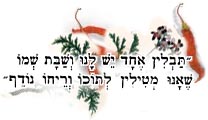|

| The Emperor (probably Hadrian)
asked Rabbi Joshua Ben Hananiah, "What gives your Sabbath meal
such an aroma?" To this R. Joshua replied, "We have a
certain spice (tavlin) called the Sabbath which we put into
it [the Sabbath dish], and this gives it its aroma." [1] |

The Bible has no special word for spice. In the talmudic and
midrashic literature, the term tavlin is used, from the verb  (t-v-l), tavel, which is apparently connected with the root balol
(“to mix”). Pungently spiced foods were very popular among the Jews
of Erez Yisrael and Babylonia, even as they are today among oriental Jews; it
has been suggested that the more pungent-tasting ones (such as pepper) also
have some disinfectant action, important under the inferior conditions of food
hygiene prevalent in the East.
(t-v-l), tavel, which is apparently connected with the root balol
(“to mix”). Pungently spiced foods were very popular among the Jews
of Erez Yisrael and Babylonia, even as they are today among oriental Jews; it
has been suggested that the more pungent-tasting ones (such as pepper) also
have some disinfectant action, important under the inferior conditions of food
hygiene prevalent in the East.
The general name for spices in rabbinic literature is  mashbihei
okhelin (“food enhancers)[2],
or alternatively (and less commonly) mashbihei
okhelin (“food enhancers)[2],
or alternatively (and less commonly)  zikei kiderah (fluid spices in the cooking pot) is also used.[3]
Among the “food improving” spices may also be included pungent-tasting
vegetables, such as garlic, leek and onion. Some aromatic plants (incenses and
perfumes), such as cinnamon and saffron, were also used as spices. In addition
to these aromatic plants and vegetables, the Bible also mentions four kinds
of spices — hyssop, caper, cumin, and fennel-flower, while talmudic literature
refers to dozens of varieties, the most important of which are the following:
zikei kiderah (fluid spices in the cooking pot) is also used.[3]
Among the “food improving” spices may also be included pungent-tasting
vegetables, such as garlic, leek and onion. Some aromatic plants (incenses and
perfumes), such as cinnamon and saffron, were also used as spices. In addition
to these aromatic plants and vegetables, the Bible also mentions four kinds
of spices — hyssop, caper, cumin, and fennel-flower, while talmudic literature
refers to dozens of varieties, the most important of which are the following:
|
ammomum
(hamam, of the ginger family): seed added to coffee by Oriental communities
(hel in Arabic)
asafetida (hiltit): spice still used in Iran.
caper (the fruit aviyyonah; the flower buds zalat):
eaten picked in salt or vinegar
caraway (karbos): seed used as spice, thick root eaten as
vegetable.
costus (kosht, of the ginger family): “food enhancer,”
ingredient in incense used in the Temple.
|
|
mint
(na’ana, Arabic name): leaves used as a spice and yield an
ethereal oil.
mustard (hardal):
condiment extracted from the seeds.
pepper (pilpil): most popular spice.
rue (pigam): leaves have pungent aroma, used by Oriental
communities.
safflower (kozah, kurtama, morika): leaves used as a spice
and its seed as food and spice.
saffron (karkom): stigmas of the flower used as a spice
and a dye.
|
cumin
(cammon): used as spice on bread
during biblical and Talmudic periods.
dill (shevet): used in mishnaic times as a spice.
dodder (keshsut): fruit used a spice, mainly in wine.
fennel (gufnan in Mishnah; shumar in Talmud): spice
similar to dill.
Fennel-flower (kezah): seed used as a spice on bread.
hyssop (ezov): leaves used as a spice.
lavender (ezovyon): leaves used as a perfume and medicine. |
savory
(si’ah): wild spice,
mentioned together with hyssop and thyme.
sesame: oil of seed used as a food and in lamps.
sumac (og): fruit of the sumac tree, used as a spice.
thyme (koranit): tiny aromatic leaves have pungent aroma,
used as a spice, like hyssop and savory (three are mentioned together). |
The rabbis composed blessings of thanksgiving for personal
enjoyments and benefits (birkhot ha-nehenin), among several blessings
to be recited upon smelling fragrant plants and spices:[4]
On smelling fragrant woods or barks:
Blessed are You, O Lord our God, King of the Universe,
who creates diverse kinds of spices.
|
|
On smelling fragrant plants:
Blessed are You, O Lord our God, King of the Universe,
who creates fragrant plants. |
|
On smelling fragrant spices:
Blessed are You, O Lord our God, King of the Universe, who creates fragrant
woods |
|
On smelling fragrant oils:
Blessed are You, O Lord our God, King of the Universe,
who creates fragrant oil. |
|
|
[1] JT Shabbat 119a [back]
[2] Sif. Deut. 107; several kinds of spice
are mentioned here. [back]
[3] Yoma 75a;; Hul. 77b
[back]
[4] BT Berkhot 43b [back]
|
|